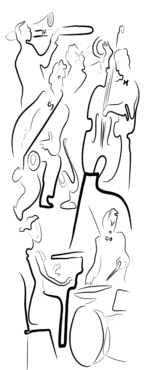Main Guidelines
We hire a number of different DJs because we want to hear the
diversity of sound and music that you bring to the event.
We respect you as a DJ, otherwise we wouldn't be asking you
to DJ at our event.
However, each event is different in what it is looking for, so
here are some guidelines for the music we want at TRP.
- Watch The Floor
-
We want to provide dancers with the music they want to Lindy and
Blues to. During your set, make sure you're watching the floor and
catering to the energy and feel that your dancers are looking for.
You may have a great song, and it may get people revved up another night, but if
the crowd is looking for a different energy, then cater to it.
It's also good sense to watch the more experienced dancers. Consider
them as your canary in the coal mine. If your experienced dancers
are sitting out, it's important to change the music you're playing to
a type that brings them back onto the floor.
- Obscurity Is Not Good.
-
To quote Norma Miller, "Obscure music is obscure for a reason".
Keep in mind that as a DJ you are likely to get tired of music long
before the dancers. David is not a DJ, but is capable of playing a
good Blues set that'll impress dancers because he simply plays the
amazing Blues songs that dancers love but DJs have written off their
list. Please put these songs back in your rotation and put David out
of business as a DJ, he's not really that good.
- CDJS (Clever DJ Syndrome)
-
Your job as a DJ is not to be clever, your job is to be good.
If you're playing a song in the hopes that people will run up to the
DJ booth and ask what the song is, or will smile at how clever you
are, then you're almost guaranteed to not be playing the right song
for TRP. Keep it simple. There are lots of great songs out there
to choose from, don't show us how sneaky or clever you are. Our
first priority is getting people to dance, not educating
them about the music.
- Aim To Please Everyone
-
If you play a song that 50% of the crowd loves, chances are that 50%
of the crowd hated it as well, and you have failed in our eyes. We
don't want you aiming for 50%, or even 80% or 90%. Aim at making everyone
happy with the music. If a portion of the floor goes wild, and a portion
of the floor walks off, then we're not happy. Keep everyone dancing!
Lindy Music
Back in the end of the '90s, San Francisco was the world center for Swing.
At The Rent Party, we think that was because of a specific style of music
that was centered around the opening of the Doghouse and The 9:20 Special,
often referred to as Groove Lindy. And while this stylistic choice has
it's influence on the 9:20 of today, it's fair to say that the current
9:20 Special and the Doghouse (at the end) are/were playing a slightly
different style of music than the early days.
Now, we know that you can't go back in time, but that doesn't mean we
can't resurrect a style (heck, we're all dancing an old dance here, right?),
and that's what we're generally aiming for. Think of it as the livelier
side of Groove Lindy, the kind of music that makes people feel like they're
at a party and want to dance. Touches of Classic Swing are fine, but nothing
so fast that an intermediate dancer can't swing out (watch the floor!).
We're not looking for the kind of Classic swing that has an even,
metronomic backbeat. We already have a Blues room, so nothing that
you think would go there should be played in the Lindy room.
Examples: "Rockhouse" by Ray Charles, "Lavender Coffin" by Lionel
Hampton, "Golden Earrings" by Ray Bryant, "For Dancers Only" by
Junior Mance, "Smack Dab In The Middle" by Gene Harris & Jack McDuff,
"Going To Chicago" by Ernestine Anderson, and "Hard Times" by Ray
Charles and Houston Person, "Blues For Eileen" by Atomic Basie,
"Smooth Sailing" by Ella Fitzgerald.
Blues Music
A simple classification of types of music played at Blues Dance venues
would probably contain:
- "Vintage" Blues (early 1900s, jazz)
- Contemporary Blues
- Fusion Blues ("Turquoise")
- Fusion non-Blues (Tango, Hip-Hop, etc..)
In general we are looking for Contemporary Blues with some "Vintage" Blues.
We are
not interested in
ANY Fusion NON-Blues for our event,
nor should DJs try to sneak even one such song in (see
CDJS
above).
We are, however, starting to introduce some Fusion
Blues into
our mix. This should never be more than 1/4th of the music you play.
I know that the distinction between #3 and #4 above isn't terribly
clear, but one rule of thumb is that if it clearly belongs to another
dance genre, then we do not want it played at TRP ever. If you
have questions, be sure to ask one of the organizers.
If you choose to play Vintage Blues that's fine, but it better be
great, and the recording quality needs to be high enough
that it is still good to listen and dance to.
Examples: "Come On In My Kitchen" by Robert Johnson , "I Live The
Life I Love" by Buddy Guy, "The Thrill Is Gone" by B.B. King, "Boom
Boom" by John Lee Hooker, "Black and Tan Fantasy" by Lincoln Center
Jazz Orchestra, "St. James Infirmary" by Lou Rawls, "Feeling Good" by
Nina Simone and "Dr. Feelgood" by Kim Massie.

